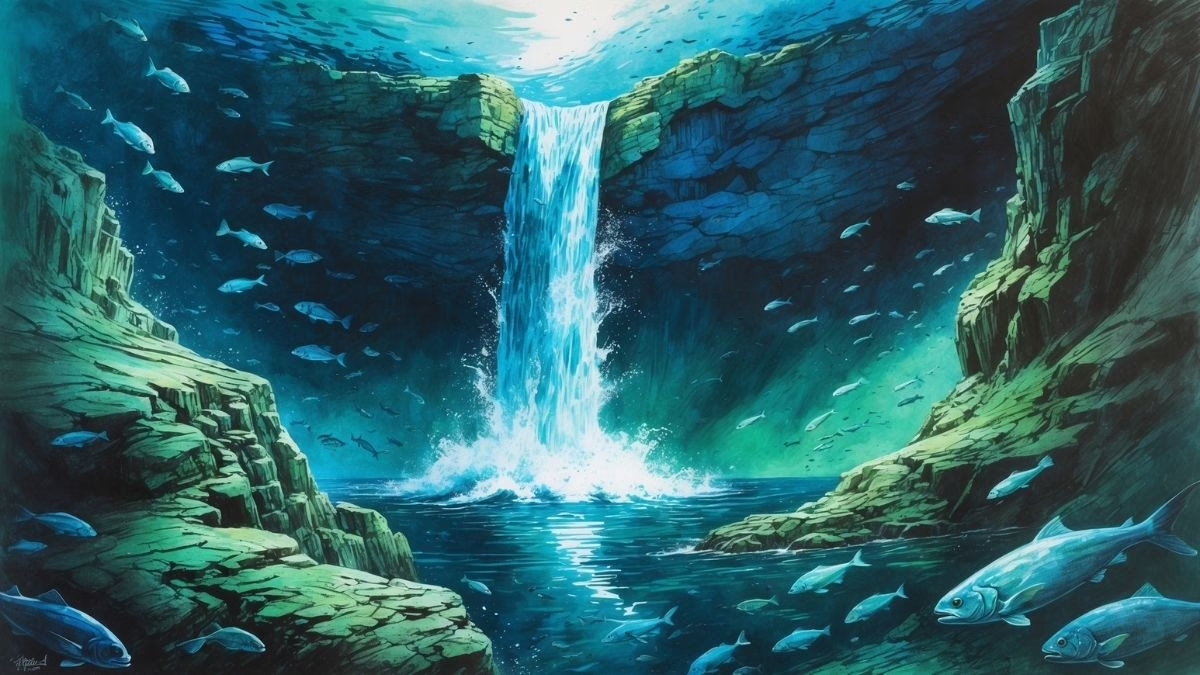MagTalk
A Paradoxical Plunge
Picture a waterfall. What comes to mind? Probably the thunderous roar of Angel Falls in Venezuela, plummeting from a height that seems to touch the clouds. Or perhaps the sheer, awesome power of Niagara, a curtain of white fury separating two nations. We associate waterfalls with towering cliffs, misty air, and the relentless, visible force of gravity pulling a river over an edge. They are landmarks of the terrestrial world, spectacles of freshwater fury. Now, what if I told you that the largest waterfall on planet Earth is completely invisible to the naked eye, makes almost no sound, and is found not on a continent, but deep beneath the waves of the Atlantic Ocean?
This is not a riddle or a flight of fancy. It is a staggering oceanographic reality. Hidden in the cold, dark waters between Greenland and Iceland lies the Denmark Strait cataract, a feature so immense that it dwarfs every cascade on land. It is a waterfall of seawater, a continuous, colossal plunge of one part of the ocean into another. Its existence challenges our very definition of a waterfall and reveals a hidden architecture to the deep sea, a world of unseen rivers, mountains, and cataracts that is far more dynamic than we ever imagined.
In this article, we will dive deep into the science behind this astonishing phenomenon. We will explore the simple yet powerful physics of water density that drives this underwater marvel. We will grapple with its mind-boggling scale, a flow of water so vast it beggars belief. And we will uncover its profound importance, learning how this single feature acts as a critical engine in the vast, globe-spanning circulatory system that regulates our planet’s climate. Prepare to have your understanding of the ocean turned upside down, as we journey to the bottom of the sea to witness the silent, majestic power of the world’s greatest waterfall.
The Science of the Sinking Sea: How Does This Even Work?
It’s All About Density, Not Gravity
A waterfall on land is simple. Water in a river reaches a cliff, and gravity does the rest. An underwater waterfall, however, can’t work that way; it’s already underwater. The driving force is not a cliff in the traditional sense, but a cliff of density. The entire phenomenon is a spectacular demonstration of a fundamental principle: when fluids of different densities meet, the denser fluid will sink below the less dense one. You see this every time you mix oil and vinegar for a salad dressing; the denser vinegar sinks to the bottom.
The Denmark Strait cataract operates on this same principle, but on an oceanic scale. The story begins in the Nordic Seas, north of the strait. Here, the frigid arctic air chills the surface waters. As seawater gets colder, it gets denser. Furthermore, as some of this water freezes to form sea ice, it leaves its salt behind in the remaining liquid, making that water even saltier. This combination of being extremely cold and extra salty makes the water of the Nordic Seas some of the densest in the entire world.
This incredibly dense water then begins to move south. As it travels, it meets the warmer, less salty, and therefore much lighter waters of the Irminger Sea, which is part of the North Atlantic. This meeting point, the Denmark Strait, is not just an open passage. Beneath the waves lies a massive underwater ridge, a submarine sill that rises from the seafloor, connecting Greenland and Iceland.
The Plunge Over the Precipice
This submerged ridge is the “cliff” for our underwater waterfall. The dense, heavy water from the Nordic Seas, flowing south along the seafloor, reaches this underwater precipice. Unable to mix easily with the lighter Atlantic water above it, it does the only thing it can: it spills over the edge.
And what a spill it is. The cold, dense water cascades down the southern face of the ridge, plunging into the abyssal depths of the Atlantic basin. This isn’t a sheer, vertical drop like Angel Falls. It’s more like a river of cold water flowing rapidly down a very, very steep continental slope. But in every functional sense, it is a waterfall. It is a continuous, gravity-driven flow of water moving downwards through other water, purely because of its greater density. This process, where water sinks due to its temperature (thermo) and salinity (haline), is a key part of what oceanographers call thermohaline circulation, a concept we’ll soon see is critical for the entire planet.
The Scale of the Colossus: Bigger Than You Can Imagine
By the Numbers: Dwarfing the Giants
It is almost impossible for the human mind to truly comprehend the scale of the Denmark Strait cataract. The numbers are so astronomical they verge on the absurd. Let’s try to put it in perspective.
The drop itself is estimated to be around 3,500 meters (11,500 feet). That is more than three times the height of Angel Falls, the tallest waterfall on land. It’s a plunge so deep that you could stack seven of the Empire State Buildings on top of each other and the top would still not break the surface of the “river” before it starts its descent.
But the height, while staggering, is not the most impressive statistic. The truly mind-boggling figure is the flow rate. The Denmark Strait cataract moves, on average, between 3 and 5 million cubic meters of water per second. Let’s try to visualize that. The Amazon River, the mightiest river on Earth, has a flow rate of about 209,000 cubic meters per second at its mouth. This means the silent, invisible waterfall under the sea has a flow rate that is roughly 20 to 25 times greater than the Amazon. It is more powerful than the flow of all the world’s freshwater rivers combined. It is a force of nature on a scale that has no terrestrial equivalent.
An Unseen, Unheard Spectacle
What makes this colossus so fascinating is its imperceptible nature. If you were in a ship on the surface of the Denmark Strait, you would have no idea that a spectacle of this magnitude was unfolding thousands of feet below you. There is no roar, no mist, no visible turbulence on the surface. It is a silent giant.
The flow is not a clear, sharp-edged cascade. It is a turbulent, chaotic mixing zone. As the dense water plunges downwards, it entrains, or pulls in, some of the warmer, lighter water it is falling through. This means the “river” actually grows in volume as it descends, becoming a churning, swirling mass of mixed water by the time it reaches the abyssal plain. Scientists studying this phenomenon use moored instruments, floats, and acoustic imaging to “see” the waterfall, mapping its temperature and salinity to understand its structure and power. It is a testament to scientific ingenuity that we can witness and measure a feature of such colossal scale that remains completely hidden from our direct senses.
A Planetary Heartbeat: Why the Cataract Matters
The Engine of the Global Conveyor Belt
The Denmark Strait cataract is not just a geological curiosity; it is a vital organ in the planet’s circulatory system. It is one of the primary engines of the Atlantic Meridional Overturning Circulation (AMOC), a vast, globe-spanning current system often referred to as the “global conveyor belt.”
The AMOC works like a giant thermostat and nutrient delivery service for the planet. Warm, salty water flows northward from the tropics on the surface of the Atlantic. As it reaches the high latitudes of the Nordic and Labrador Seas, it releases its heat into the atmosphere, helping to keep Europe and North America much warmer than they would otherwise be. Having lost its heat, this water becomes cold and dense. This is where the cataract comes in. The sinking of this dense water in places like the Denmark Strait is the critical “overturning” part of the circulation. It’s the “deep water formation” that drives the whole system. Once this water plunges into the abyss, it forms a deep, cold current that flows south, deep beneath the surface, all the way to the Southern Ocean, eventually rising to the surface (upwelling) in the Pacific and Indian Oceans, where it warms up and begins its long journey back to the North Atlantic.
A Climate Regulator and a Fragile Future
This conveyor belt is profoundly important. It transports heat, salt, and dissolved gases like oxygen and carbon dioxide around the globe. The deep water formed in the North Atlantic carries oxygen down to the abyssal depths, allowing life to exist in the deep sea. The whole system also plays a crucial role in regulating our climate by absorbing enormous amounts of heat and carbon dioxide from the atmosphere.
This makes the health of the Denmark Strait cataract a topic of intense scientific scrutiny, especially in the context of climate change. The system is driven by differences in temperature and salinity. As the Arctic warms and glaciers in Greenland melt, they are releasing vast amounts of fresh, buoyant water into the North Atlantic. This influx of freshwater could, in theory, dilute the salty surface waters, making them less dense and less likely to sink. If the sinking process were to slow down or even shut down, it could have dramatic and unpredictable consequences for the climate of the Northern Hemisphere and for marine ecosystems worldwide.
Understanding this colossal, hidden waterfall is therefore not just an academic exercise. It is crucial for predicting the future of our planet’s climate. The silent giant at the bottom of the ocean is a powerful reminder of the intricate and often invisible systems that keep our world in balance.
The Wonder of the Deep
The Denmark Strait cataract is a monument to the humbling complexity of our planet. It is a feature that defies our everyday intuition, a waterfall bigger than any on land, hidden in a realm of perpetual darkness. It reminds us that even in the 21st century, the ocean remains a place of profound mystery and discovery, a world where our maps are still being drawn.
This underwater colossus is more than just a record-holder. It is a testament to the simple laws of physics playing out on a planetary stage, with the power to shape global climate and enable life in the deepest, darkest corners of the sea. It is a paradox: a force of unimaginable power that is utterly imperceptible from the surface, a feature of global importance that most of humanity doesn’t even know exists. The next time you see a picture of our blue planet from space, remember what lies hidden beneath the waves. Remember the silent, sinking rivers and the colossal cascades, the unseen engines that make our world work. The greatest wonders are not always the ones we can see.
Focus on Language
Vocabulary and Speaking
Welcome to the language gymnasium, where we’re going to build some verbal muscle. It’s one thing to understand a topic, but it’s another to be able to discuss it with confidence and precision. A rich vocabulary is the key; it gives you the tools to express nuanced ideas and to paint vivid pictures with your words. Today, we’re going to unpack ten fascinating and useful words and phrases from our article on the Denmark Strait cataract. We’re going to get to know them, see how they were used, and figure out how you can start using them to sound more articulate and insightful. After our vocabulary workout, we’ll move into a speaking lesson focused on making big, abstract numbers feel real and impactful.
Let’s dive in with our first word: colossal. The Denmark Strait cataract was described as a colossal plunge and an underwater colossus. Colossal means extremely large or great. It comes from the Colossus of Rhodes, a legendary, gigantic statue from the ancient world. This isn’t a word you use for something that’s just “big.” It’s for something that is so large it’s almost difficult to comprehend. A skyscraper can be tall, but a plan to build a city on Mars is a colossal undertaking. You could say, “The company made a colossal mistake that cost them billions of dollars.” Or, “The new aircraft carrier is a colossal piece of engineering.” It’s a word that conveys a sense of awe and immense scale.
Next up, we have beggars belief. I wrote that the scale of the cataract “beggars belief.” This is a great idiomatic phrase. If something beggars belief, it is impossible or very difficult to believe. The idea is that the reality is so extreme it makes any description or attempt to believe it seem poor or inadequate (like a beggar). It’s a much more powerful and sophisticated way of saying “it’s unbelievable.” For example, “The fact that he survived the fall from that height absolutely beggars belief.” Or, “The level of corruption uncovered in the report beggars belief.” It expresses a sense of shocked disbelief.
Our third term is imperceptible. The cataract was described as having an imperceptible nature. If something is imperceptible, it is so slight, gradual, or subtle that it is not noticed or felt. You can’t perceive it with your senses. A change can be imperceptible, a sound can be imperceptible, a movement can be imperceptible. For example, “The shift in the company’s strategy was imperceptible at first, but it led to major changes over time.” Or, “He gave an almost imperceptible nod of agreement.” It’s a precise word for something that exists but is below the threshold of our normal awareness.
Let’s talk about the word paradox. The introduction referred to the cataract as a paradoxical plunge. A paradox is a seemingly absurd or self-contradictory statement or proposition that when investigated or explained may prove to be well-founded or true. The classic example is “This statement is false.” An underwater waterfall is a paradox because our concept of a waterfall requires it to be in the air. You can use this word to describe any situation that seems to contain contradictory truths. “It’s a paradox that in our age of digital connection, many people report feeling more lonely than ever.” Or, “He is a paradox: a ruthless businessman who is also an incredibly generous philanthropist.”
Now for a fantastic adjective: staggering. I used it to describe the oceanographic reality and the height of the cataract. Staggering means deeply shocking or astonishing. It literally means something that is so shocking it might make you stagger or stumble. It’s a very strong word for “amazing” or “surprising.” You can talk about a staggering amount of money, a staggering achievement, or staggering news. “The team’s comeback from a 20-point deficit was nothing short of staggering.” Or, “The sheer number of stars in our galaxy is a staggering thought.”
Our sixth word is confluence. While not in the final text, it perfectly describes the meeting of the two seas. A confluence is the junction of two rivers, especially rivers of approximately equal width. More broadly, it means a coming or flowing together, a meeting, or a gathering at one point. It can be used for rivers of people, ideas, or events. For example, “The city of Pittsburgh is located at the confluence of three rivers.” Or, metaphorically, “Her work is a fascinating confluence of art, science, and technology.” It’s a beautiful word for a meeting or merging point.
Let’s move to profound. The cataract’s importance was described as profound. Profound means very great or intense, or having or showing great knowledge or insight. It suggests depth and seriousness. You can have a profound effect, a profound sense of sadness, or a profound understanding of a subject. It’s a much weightier word than “big” or “deep.” “The death of his mentor had a profound impact on his life and work.” Or, “She didn’t speak often, but when she did, her comments were always profound.”
Next, we have the verb to entrain. I wrote that the plunging water “entrains, or pulls in, some of the warmer, lighter water.” In this scientific context, to entrain means to draw in and transport something (like a fluid or solid particles) by the flow of a fluid. While it’s a bit technical, its metaphorical use is fantastic. It can mean to get things caught up in a process. For example, “The political scandal threatened to entrain several innocent people who were only loosely connected to the main figures.” It suggests being pulled into a larger, moving force against your will.
Our ninth word is stewardship. This word wasn’t in the final article, but it’s the natural conclusion when discussing the cataract’s fragility. Stewardship is the job of supervising or taking care of something, like an organization or property. It implies a sense of responsible management and care for something precious, often on behalf of others. It’s a key concept in environmentalism and leadership. “The national park system is based on a principle of stewardship, preserving nature for future generations.” Or, “As CEO, she felt a strong sense of stewardship for the company’s employees.” It’s a noble word that speaks of responsibility over ownership.
Finally, let’s look at the adjective abyssal. The cataract plunges into the abyssal depths. Abyssal relates to the abyss or the deep ocean. The abyssal zone is the pitch-black bottom layer of the ocean. The word abyss itself means a deep or seemingly bottomless chasm. We use it to describe things that are extremely deep, dark, and mysterious. You can talk about an “abyssal plain” on the ocean floor, or you can use it metaphorically. “He stared into the abyss of his own despair.” Or, “There is a abyssal gulf between their political viewpoints.” It conveys a sense of immense, almost terrifying, depth.
Now, let’s switch gears to speaking. Today’s speaking lesson is about making numbers meaningful. The article was full of huge, abstract numbers—3,500 meters, 5 million cubic meters per second. Just saying these numbers doesn’t have much impact. The key to making them powerful is to contextualize them through comparison and analogy.
Instead of just saying “3,500 meters deep,” the article says “more than three times the height of Angel Falls.” Instead of just saying “5 million cubic meters per second,” it says “roughly 20 to 25 times greater than the Amazon River.” This is the magic trick. You take a number your audience can’t visualize and compare it to something they can visualize.
You can use this technique for any kind of data.
- Large numbers: “The national debt is 30 trillion dollars.” (Meaningless). “That’s enough money to give every single person in the country about $90,000.” (Meaningful).
- Small numbers: “The microprocessor is 14 nanometers wide.” (Meaningless). “That’s so small you could fit about 7,000 of them across the width of a single human hair.” (Meaningful).
- Time: “The universe is 13.8 billion years old.” (Meaningless). “If the entire history of the universe were compressed into a single year, all of human history would happen in the last 14 seconds before midnight on New Year’s Eve.” (Meaningful).
Now for your challenge. Your assignment is to find a statistic or a large number from the news, a book, or your own work. Your goal is to explain this number out loud to someone (or just to your phone’s recorder) in two or three sentences.
The task is this: you cannot just state the number. You must make it meaningful by using a comparison or an analogy to put it in a context the listener can understand. For an extra challenge, try to use one of our vocabulary words.
For example, if your statistic is “About 400,000 tons of plastic waste enters the ocean every year.” You could say: “The amount of plastic entering our oceans is staggering. We dump about 400,000 tons of it in there every single year. To put that in perspective, that’s like driving 800 fully loaded jumbo jets to the coast and pushing them into the water, year after year.”
See how the jumbo jet analogy makes the abstract number suddenly feel heavy and real?
Record yourself. Does your comparison make the number easier to understand? Does it have more emotional impact? This skill is crucial for anyone who works with data and wants to be a persuasive communicator. It’s how you turn data into a story.
Grammar and Writing
Welcome to the writer’s workshop, the space where we learn that good writing is not about magic, but about making smart choices. Grammar provides the framework for those choices, allowing us to build sentences that are clear, dynamic, and engaging. Today, we’re going to tackle a writing challenge that asks you to explain a natural wonder, and then we’ll dissect some powerful sentence-level techniques to help you do it with style and grace.
Here is your writing challenge:
Write a short, vivid description (around 300-400 words) of a complex natural phenomenon as if you were explaining it to a curious friend. Your goal is to make it exciting and understandable. Choose any phenomenon you find interesting: the Northern Lights, a volcanic eruption, photosynthesis, a thunderstorm, etc. You must use at least one example of an “absolute phrase” to add detail and at least one “rhetorical question” to engage the reader.
This challenge is about balancing scientific accuracy with narrative flair. You need to be clear, but you also want to create a sense of wonder. The key is in how you structure your sentences to deliver information and evoke emotion at the same time.
Let’s get into the grammatical toolkit for this task.
1. The Stylistic Flourish: The Absolute Phrase
This is a slightly more advanced grammatical structure, but it is a secret weapon for creating vivid, dynamic prose. An absolute phrase is a group of words that modifies an entire sentence, not just a single noun. It consists of a noun or pronoun followed by a participle (-ing or -ed form of a verb) and any related modifiers. It’s set off by a comma and adds a “zoom-in” detail or a “camera-angle shift” to your main sentence.
Let’s break it down:
- Main Sentence: The scientist watched the screen.
- Add an Absolute Phrase: The scientist watched the screen, her heart pounding with anticipation.
- (The phrase “her heart pounding with anticipation” modifies the entire scene. “Heart” is the noun, “pounding” is the participle.)
- Main Sentence: The storm finally broke.
- Add an Absolute Phrase: The storm finally broke, its fury unleashing rain in horizontal sheets.
Absolute phrases are incredible for description because they let you add a secondary action or detail without starting a new sentence. They create a “cause-and-effect” or “whole-and-part” relationship that makes your writing feel more sophisticated and cinematic.
- Example for the challenge (describing a volcano): “Deep beneath the earth, magma began to rise, the pressure building to an unbearable degree. The mountain trembled, its peak shrouded in a plume of ominous grey smoke.“
For your challenge, find a moment of high action or description and add an absolute phrase to give it an extra layer of detail and dynamism.
2. The Engine of Engagement: The Rhetorical Question
A rhetorical question is a question you ask not to get an answer, but to make a point, create a dramatic effect, or get your reader to think. It’s a powerful tool in explanatory writing because it pulls the reader into the conversation. It shifts them from being a passive recipient of information to an active participant in the inquiry.
- Instead of: “It is amazing how this works.”
- Try: “But how does this possibly work?“
Asking the question directly makes the subsequent explanation feel like an answer, a revelation. It creates a sense of mystery and anticipation.
- From the article: “Picture a waterfall. What comes to mind?” and “How does this even work?” These questions directly engage the reader before diving into the explanation.
For your challenge, find a key point in your explanation where you want to increase engagement. Pause, and ask a rhetorical question that you then proceed to answer. It will make your writing feel more like a conversation and less like a lecture.
Putting It All Together: A Writing Strategy
Let’s outline a structure for your descriptive piece using these tools.
- Introduction (The Hook & The Question): Start with a familiar image, then pivot to the wonder of your chosen topic. Use a rhetorical question to set up the mystery.
- Example (describing the Northern Lights): “We’ve all seen pictures of them: ethereal curtains of green and purple light dancing in the polar sky. They look like pure magic. But what are they, really? What causes our planet’s atmosphere to ignite in such a staggering display?”
- Body Paragraph 1 (The “How”): Begin to explain the science. Use clear language and analogies. This is a great place to use an absolute phrase to add detail.
- Example: “It all starts 93 million miles away, with the sun. The sun is constantly spewing out a stream of charged particles called the solar wind. This cosmic gale hurtles through space, its invisible particles carrying an immense electrical charge. Most of it is deflected by Earth’s magnetic field, our planet’s invisible shield.”
- Body Paragraph 2 (The Climax): Describe the climactic moment of the phenomenon. Use vivid, sensory language.
- Example: “But some of those solar particles get trapped, funneled down the magnetic field lines towards the poles. Their journey ending in a blaze of glory, they slam into the gases in our upper atmosphere—oxygen and nitrogen. The result? A colossal, silent light show. The collision excites the gas atoms, and as they calm down, they release that energy as light. Oxygen glows green and red; nitrogen shines in hues of blue and purple. It’s a planetary-scale neon sign, powered by the sun.” (Notice the absolute phrase and the strong, descriptive verbs).
- Conclusion (The Takeaway): End with a final thought that reinforces the sense of wonder.
- Example: “So the next time you see a photo of the aurora borealis, remember what you’re witnessing. It’s not magic, but the beautiful, tangible result of a cosmic dance between our star and our world. A paradoxical combination of violent solar physics and silent, graceful beauty.”
Your challenge is to use this model to bring your chosen natural phenomenon to life. Engage your reader with questions, paint vivid pictures with absolute phrases, and create a sense of awe and understanding all at once.
Vocabulary Quiz
Let’s Discuss
These questions are designed to encourage you to think more broadly about the deep ocean, scientific discovery, and our relationship with the planet’s hidden systems. Use them to start a conversation and share your perspective.
- The Shock of the Unseen:
- The article highlights that the world’s largest waterfall is completely invisible from the surface. What does this fact tell you about our perception of our own planet? How many other colossal, vital phenomena might be happening that we are completely unaware of?
- Deeper Dive: Discuss the psychological impact of major scientific discoveries that challenge our everyday understanding of the world (e.g., the Earth revolving around the sun, plate tectonics, quantum mechanics). Why do you think humans are so fascinated by these hidden realities?
- Exploring the Abyss:
- We know more about the surface of Mars than we do about our own planet’s seafloor. Given the immense cost and technical challenges, how much should we prioritize the exploration of the deep ocean?
- Deeper Dive: Debate the allocation of scientific funding. What is the right balance between space exploration (like searching for life on other planets) and ocean exploration (understanding life and systems on our own)? What are the potential benefits and discoveries that could come from a more robust deep-sea exploration program?
- The Fragile Engine:
- The article explains that the Denmark Strait cataract is a critical engine for the AMOC, which regulates climate, and that it’s vulnerable to changes from melting ice. This is a huge, powerful system, yet it’s also delicate. How does this paradox change how you view climate change?
- Deeper Dive: Discuss the concept of “tipping points” in Earth’s climate system. Does learning about a specific, tangible mechanism like the Denmark Strait cataract make the abstract threat of climate change feel more real or urgent to you? How can scientists better communicate the risks to these complex, interconnected systems?
- A “Waterfall” by Any Other Name?
- The Denmark Strait cataract isn’t a waterfall in the traditional sense. It’s a flow of dense water through less-dense water. Does calling it a “waterfall” help us understand it, or is it a slightly misleading analogy?
- Deeper Dive: Talk about the role of language and metaphor in science. How do the names and analogies we use shape our understanding of scientific concepts? Can you think of other scientific ideas that rely on powerful (or potentially misleading) metaphors?
- Our Responsibility as Stewards:
- Most of us will never see or directly experience the Denmark Strait cataract, yet its health is vital to the climate we all share. What does “stewardship” mean for a global system that is so remote and invisible?
- Deeper Dive: Brainstorm what individual, national, and international stewardship of the global ocean system looks like. Does it mean reducing personal carbon footprints? Supporting international climate agreements? Funding more oceanographic research? Discuss how we can foster a sense of connection to and responsibility for parts of the planet we can never visit.
Learn with AI
Disclaimer:
Because we believe in the importance of using AI and all other technological advances in our learning journey, we have decided to add a section called Learn with AI to add yet another perspective to our learning and see if we can learn a thing or two from AI. We mainly use Open AI, but sometimes we try other models as well. We asked AI to read what we said so far about this topic and tell us, as an expert, about other things or perspectives we might have missed and this is what we got in response.
Hello there. It’s a pleasure to have a moment to dive a bit deeper, to explore the currents beneath the surface of the main article. We’ve established the “what” and the “why” of the Denmark Strait cataract, this colossal, hidden feature. But I want to touch on two aspects we only glossed over: the how of studying it, and the fact that it’s not alone—it’s part of a whole family of these deep-sea phenomena.
First, let’s talk about the sheer, audacious challenge of observing this thing. It’s one of the most hostile environments on Earth. It’s two miles deep, the pressure is crushing, the water is near freezing, and the currents are incredibly powerful and turbulent. You can’t just send a submarine down there to have a look around. The turbulence would be like trying to fly a helicopter through a hurricane. So how do we know what we know? The answer is through an incredible array of remote and robotic technologies.
Oceanographers create what are called moorings. Imagine a long, long cable, sometimes miles long, anchored to the seafloor with a heavy weight and held taut by a series of buoyant floats. All along this cable, scientists attach a suite of instruments: current meters, temperature sensors, salinity sensors. They leave these moorings in the water for a year or two at a time, and the instruments record a continuous stream of data, giving us a time-lapse movie of the water flowing past at different depths. It’s how we measure the cataract’s flow rate and its variability. We also use autonomous underwater vehicles, or AUVs—torpedo-shaped robots that can be programmed to “swim” through the cataract, creating high-resolution 3D maps of its temperature and salinity structure. It’s a testament to engineering that we can get such precise data from a place we can never visit.
The second point is that the Denmark Strait, while the biggest, is not the only place this happens. Deep water formation is a critical process, and it occurs in a few key, geographically specific locations around the world. There’s another significant overflow in the North Atlantic, where cold water spills over the ridge between Iceland and the Faroe Islands. But the other major engine of the global deep ocean circulation is at the opposite end of the planet: Antarctica.
Around the coast of Antarctica, a similar process occurs, but it’s even more intense. As sea ice forms in the incredibly cold polar winters, the salt left behind creates the densest seawater on the planet: Antarctic Bottom Water (AABW). This water is so dense it sinks right down the continental slope and forms the absolute bottom layer of the world’s oceans. This AABW from the south and the North Atlantic Deep Water (NADW) from the north are like two massive, slow-motion rivers that fill up the abyssal plains of all the major ocean basins. They don’t mix easily; the slightly “lighter” NADW actually flows on top of the heavier AABW. So when you look at a cross-section of the Atlantic Ocean, you see this incredible, invisible layering of water masses, each with its own distinct history and origin. The Denmark Strait cataract is the most spectacular single feature, but it’s part of a global, interconnected system of sinking waters that drive the entire ocean. It’s a planetary-scale plumbing system, and we’re only just beginning to understand all its intricate connections.











0 Comments